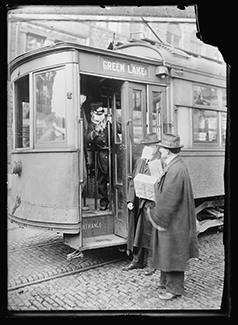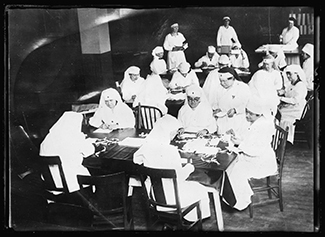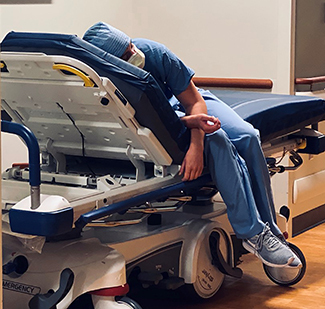Collecting Michigan's coronavirus story
By CASEY WARNER
Michigan Department of Natural Resources

Face masks and hand sanitizer. College campuses and schools empty of students. Store shelves empty of toilet paper and disinfectant. Seeing coworkers, friends and family only on a computer screen. No sporting events, concerts or proms.
These are just a few of the ways life in Michigan, and around the country, has changed with the advent of the coronavirus.
It’s an extraordinary, unprecedented time in our state’s history, but not the first time Michigan has faced a major pandemic.
In October 1918, a deadly strain of influenza circulating around the United States and Europe arrived in Michigan. The disease killed many more Americans than those who died in World War I.
That influenza was sometimes referred to as the “Spanish flu,” but that’s a misnomer according to Jillian Reese, curator with the Michigan History Museum.
In an article in Chronicle magazine, published by the Historical Society of Michigan, the late Richard Adler (a longtime professor of biology and microbiology at the University of Michigan-Dearborn) explained the origins of the inaccurate name:
“Because of censorship associated with the Great War in Europe, the extent of influenza among both the Central Powers as well as the Allies was rarely reported. Spain, being neutral in the conflict, was not subjected to the same degree of restriction, which resulted in the illness, known as the ‘grippe,’ often being referred to as the Spanish Flu. … The Spanish blamed the French as the source. In reality, though, the disease likely originated at Camp Funston, Kansas, which is now Fort Riley.”
|

Reflecting on what happened in the state during that pandemic a century ago to gain perspective on the state’s current situation, Michigan History Center staff members found accounts of how state and local government officials responded to the outbreak.
“Looking back into history helps us understand how to handle today’s public health emergency,” Reese said.
Lagging response
She explained that, when military personnel in Detroit, Bay City and at Camp Custer started getting sick, containment efforts were sluggish. People insisted that the flu had been around forever and had high recovery rates.
Michigan’s Gov. Albert Sleeper issued an order banning large congregations of people weeks after Michigan’s first flu deaths.
Counties and cities had to individually request further closures from the governor. Many officials waited to make these requests until the area’s hospitals were overrun and the flu had been circulating for months.
Some communities underreported infection numbers to keep businesses open. Some people protested that these restrictions were too harsh.
More than 15,000 people died of either influenza or pneumonia in Michigan between October 1918 and April 1919 – the equivalent of 50,000 people in today’s population. Michigan had 554 influenza deaths in 1917. In 1918, 6,336 died of influenza between October and December alone.
|

Some places in Michigan, such as Oscoda, Roscommon and Kalamazoo counties, saw more than a 90% increase in deaths from 1917 to 1918, and most counties saw a 20%-50% increase in deaths.
“Lax containment practices made Michigan’s influenza pandemic worse,” Reese said, explaining that hospital workers continued to go to theaters and dancehalls and families with sick members welcomed guests to their homes. The state saw spikes in infection after large community gatherings, including WWI victory parades and Thanksgiving parades in November 1918.
In all, Michigan had four influenza outbreaks. The last large community outbreak occurred in 1920, more than two years after the initial introduction of the disease.
Scant record
Researching the 1918 pandemic, Michigan History Center staff members found little information in the Archives of Michigan revealing details about the flu’s impact on Michiganders’ lives.
They don’t want that to be the case for those looking back on the current pandemic.
As a result, the Michigan History Center recently launched Collecting COVID-19, an initiative that gives state residents the opportunity to share stories that reflect their experiences during the coronavirus pandemic for the benefit of future generations.
|

“When we look back at what the state collected during the 1918 flu epidemic, we find government records, but few glimpses into what the crisis meant on a personal level,” Michigan History Center Director Sandra Clark said. “Our goal is to collect the stories of diverse Michiganders from across the state, and our hope is that the record we preserve in 2020 will help future generations understand what it felt like to live through this time.”
The COVID-19 pandemic is a critical moment in history, and the Michigan History Center is committed to documenting – through objects, archival materials, stories and experiences – how the coronavirus is affecting Michigan residents in the workplace, at home, in communities and in many other settings.
“Archives and museums preserve and share the real stuff of the past, but we also have an obligation to collect and preserve the documents, images and objects that will help future residents understand our present,” Clark said.
Stages
The first phase of the three-phase collecting initiative is active right now. It offers a web-based platform for people to share and donate photos, videos and audio files that document their lives during this emergency – all of which will be considered for preservation in the Archives of Michigan’s collections.
The site includes an image gallery that allows others to see what people are posting, in real time.
|
Stories that have been submitted so far include:
- “Being a mom is always hard. Being a mom during a pandemic is a whole new ballgame. Experiencing a global trauma comes with its own symptoms. As a mom, I have to attempt to either quickly process those symptoms or avoid them in order to stay in a good state of mind for my babies. This photo is the perfect example of that. I have a series of photos from this experience that show my son's worry, confusion and curiosity around this brand new, yet now normal, experience. It was my job to handle the situation in a way that didn’t create unnecessary fear or worry in him while also teaching him how important it is to be careful right now. It is my job to teach him how to cope during the unimaginable.” (Submitted by Megan H.)
- “We started taking long hikes in the woods with our dog every day. It was emotionally healing to be in the woods and connected with nature.” (Submitted by Sarai S.)
- “We understand Governor's policy of social distancing, but we cannot let social distancing distance our friendship. Love and friendship is what will get us through the crisis.” (Submitted by Fengyi C.)
- “My 80-year-old mom died from Covid-19 after living in a Nursing Home. Please stay home and stay safe. This virus is not a hoax or a joke. She was healthy, just old. After contracting the virus, she struggled to breathe and spent a week in the hospital where they suctioned her lungs because she was too weak to sit up and cough. Her family could not visit her or be by her side during this time because of the precautions needed so that we would not contract the virus. The nursing home was on self-quarantine for several weeks before she contracted the virus so we could not see her for more than a month and then she died alone with only strangers in haz mat suits around her. This is why non-essential travel has been limited. It's not a civil rights issue it's a public health issue. No one has immunity from this disease.” (Submitted by Jeannie K.)
- “My kids and I wanted to do something to encourage other people in our neighborhood. Our neighborhood is normally very close-knit and its been hard not to interact like we normally would, especially as the weather gets warmer. We decided to make this sidewalk chalk message because we have so much hope that this too shall pass, and we will all be spending time together in each other's backyards again in the near future!” (Submitted by Angela R.)
-
“My wife and I are both compromised by pre-existing conditions and age. We have followed all the rules set by our Governor and are so far, we are fine, We are confident the our scientists will have a vaccine for Covid, but this is not the end. We will face something similar again. Our nation was woefully unprepared for this. We learned that we are not special. We are part of a much larger community. I am thankful for our Governor, Gretchen Whitmer, for doing everything in her power to stop the spread.” (Submitted by Jon H.)

The second phase of the project is collecting three-dimensional objects and documents related to the coronavirus emergency for the Michigan History Museum system’s collections. In keeping with the “Stay Home, Stay Safe” Executive Order, this phase will begin with a call to the public to help identify items and move to physically gathering them once it is safe to do so.
The third phase involves long-term collecting of stories, through oral history and StoryCorps interviews, memoirs and other materials created during the reflection period after an immediate crisis. These materials will be preserved in both the museum and archival collections.
Learn more about the Collecting COVID-19 initiative at Michigan.gov/MHCStories.
In time of crisis, there is comfort in knowing that we are not alone and that we are not the first to experience the unimaginable. Looking back, we can see changes in science and knowledge and some similarities in human behavior.
The Michigan History Center hopes its Collecting COVID-19 project not only will document what is happening now, but also will help us and future generations understand the varied affects a pandemic can have on people and the diverse ways they cope and respond.
|
Check out previous Showcasing the DNR stories in our archive at Michigan.gov/DNRStories. To subscribe to upcoming Showcasing articles, sign up for free email delivery at Michigan.gov/DNR.
/Note to editors: Contact: John Pepin, Showcasing the DNR series editor, 906-226-1352. Accompanying photos and a text-only version of this story are available below for download. Caption information follows. Credit Michigan Department of Natural Resources, unless otherwise noted.
Text-only version of this story.
Boys: This photo, taken in Denver in 1919, shows two boys participating in a backyard workshop while school was closed for influenza. (photo courtesy of Library of Congress)
Computer: A grandmother in Bad Axe uses FaceTime to join in the annual Easter egg coloring tradition with her grandchildren in Traverse City in this photo submitted by Jean S. Comparing it to their usual in-person holiday celebration, she said, “It's not as good--but lots better than nothing at all!”
Detroit: “The Motor City with no automobiles on the road” is shown in this photo submitted by Darren M., who took over 100 photos of the streets of Detroit documenting the effects of the Michigan’s “Stay Home, Stay Safe” executive order to help slow the spread of COVID-19.
Exhausted: A “rockstar” patient care technician takes a moment of rest during a long shift in this photo submitted by Bethany S, who said: “ … This is what covid looks like, it’s needing to put your head down for 5 seconds because the weight of holding the phone while a family says goodbye to a loved one, while holding that patients hand so he doesn’t die alone is heavy on your brain. This is what covid looks like, it’s sinking into an empty stretcher because you just spent an hour at least in full PPE providing care to scared, and very sick strangers that are depending on you…”
Hope: Angela R. shared this photo of a sidewalk chalk message of encouragement her kids made for people in their close-knit neighborhood, saying, “We have so much hope that this too shall pass and we will all be spending time together in each other's backyards again in the near future!”
Hospital: An emergency hospital in Brookline, Massachusetts, to care for influenza patients in October 1918. (photo courtesy of National Archives and Records Administration)
Practice: Staffers at a family medical practice are shown in this photo submitted by Barry M. “No in person office visits. Scramble to convert to video and telemedicine. The not so Frontline healthcare. After an initial scramble and a thousand policy changes in the last few weeks the office got slow.”
Precautions: Precautions taken in Seattle during the 1918 influenza epidemic would not permit anyone to ride on the street cars without wearing a mask – 260,000 of these masks were made by local Red Cross workers in three days. (photo courtesy of Library of Congress)
Son: Megan H. submitted this photo of her son getting a medical exam and explained, “Being a mom is always hard. Being a mom during a pandemic is a whole new ballgame. … It was my job to handle the situation in a way that didn’t create unnecessary fear or worry in him while also teaching him how important it is to be careful right now. It is my job to teach him how to cope during the unimaginable.”
Wave: Fengyi C. shared this photo along with the thought that, while she understands social distancing policies, “ … we cannot let social distancing distance our friendship. Love and friendship is what will get us through the crisis.”
Workers: A January 1920 photo showing Red Cross workers in New York City turning out medical supplies and hospital equipment to be used by the city health department in its war on influenza. (photo courtesy of Library of Congress)/
|